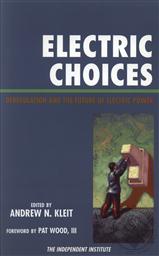Electric Choices: Deregulation and the Future of Electric Power (Book/ Paperback)
by Andrew N. KleitProduct Overview
In the late 1970s, the regulatory landscape in the United States began to change significantly as competition and deregulation were introduced to telecommunications, airlines, trucking, natural gas and oil transportation, financial services, and other industries—with impressive results. Competition increased, the pace of innovation accelerated, prices fell, and the reforms were viewed as successful. Economic restructuring and liberalization eventually came to the electric power industry but in a more piecemeal fashion.
The results have prompted a host of questions from policymakers and the public: What lessons can be learned about the successes and failures of past restructurings? How much regulation does the electric industry need? Are coordination and distribution best handled public or privately? If the latter, would for-profit or non-profit organizations better serve consumers? In Electric Choices: Deregulation and the Future of Electric Power, edited by Andrew N. Kleit (Pennsylvania State University), fifteen leading experts address these and other key issues that will determine whether electricity will become cheaper and more reliable, or more expensive and prone to blackouts.
Lessons to Learn
The Public Utilities and Regulatory Policy Act of 1978 allowed independent producers to sell electricity to utilities. New producers quickly arrived on the scene, disproving the idea that electricity generation was a natural monopoly. Passage of the Energy Policy Act of 1992 eventually forced utilities with transmissions networks to deliver power to third parties at nondiscriminatory cost-based rates. It also prompted several state utility commissions to disaggregate retail prices into generation, transmission, distribution, and transition charges.
In the mid-1990s California, Pennsylvania, Texas, and smaller states in the Northeast embarked on electricity restructuring, i.e., they opened up that sector to competition. The results varied widely. At one end of the spectrum, Pennsylvania’s restructuring was viewed as successful. On the other end, California’s electricity crisis of 2000– 2001 brought the restructuring movement to a halt, leaving electricity markets at the retail level half deregulated and half regulated.
In Chapter 2, Andrew Kleit and Timothy Considine (Pennsylvania State University) compare restructuring efforts in California and Pennsylvania. They find that even if California had not deregulated its electricity industry, it would have faced higher electricity prices for several reasons, including a shortage of generation capacity and bottlenecks in producing and delivering additional natural gas supplies for power generators.
Lynne Kiesling (Northwestern University) examines the retail side of the industry in Chapter 3. She contends that the “one size fits all” approach of regulated and fixed rates is becoming increasingly obsolete due to technological, institutional, regulatory, and cultural changes. Retail reform would not only promote a more efficient electricity market directly, it would also promote it indirectly by helping to maximize the value of other market reforms.
In Chapter 4, Stephen Rassenti, Vernon Smith, and Bart Wilson (all of George Mason University) review the use of experimental economics to inform the debate on electricity market regulation. The studies reviewed demonstrated in practical terms how electricity markets could be divided into transmission, system operation, and marketing, laying the groundwork for practical restructuring in the 1990s. In particular, experimental economics (a field for whose development Vernon Smith won a Nobel Prize) show that the use of demand-side bidding for a relatively small fraction of the market can serve to reduce price spikes and the exercise of market power. Demand-side bidding would also ease the need (or the perceived need) for price caps in many regions. Similar experimental results also show how competitive transmission markets can be constructe
About the Author(s)
Andrew N. Kleit
Andrew N. Kleit is professor of energy and environmental economics at the Pennsylvania State University. He has been an economist for the Federal Trade Commission and the Council of Economic Advisers. Dr. Kleit is the coeditor of Competition Policy Enforcement: The Economics of the Antitrust Process (1996).
List Price: $34.95
Our Price: $20.59
You Save:
$14.36(41%)
+ Free Shipping w/ $45 min. purchase
Category: Science & Technology
Format: Book (Paperback)
Publisher: Rowman & Littlefield Publishers
Date Published: Nov 09, 2006
Language: English
ISBN: 9780742548763
SKU: LT-1855
Dimensions: 5.75 x 9.00 x 0.75 (in)
Weight: 13.30 oz










